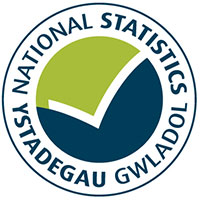Statistics on people registered to vote in parliamentary and local government elections as recorded in the electoral registers as at 2 March 2020.
This is not the latest release in the series: Electoral roll
Electoral registrations are usually collected at December every year. However, this collection of electoral statistics at 2 March 2020 has been produced to support the Parliamentary Constituency Boundary review due to finish in July 2023.
For Wales (and for England), electoral statistics are taken from data supplied to the Office for National Statistics (ONS) by local Electoral Registration Officers.
Electoral statistics are annual counts of the number of people who are registered on electoral registers and so entitled to vote.
Main points
- The total number of UK Parliamentary electors in Wales is 2,322,700; a slight increase of 0.4% between 1 December 2019 and 2 March 2020.
- This increase, compared to December 2019, reflects the full uplift due to the most recent General Election.
- The total number of local government electors in Wales is 2,358,100; a slight increase of 0.4% between 1 December 2019 and 2 March 2020.
- The total number of UK Parliamentary electoral registrations in March 2020 was the highest ever recorded, at 47,558,400, an increase of 483,600 (1.0%) compared to December 2019.
Electoral roll statistics are based on the UK Parliamentary constituency boundaries and are published for both UK Parliamentary and local government electors. Until 14 December 2011, UK Parliamentary constituency boundaries were the same as those for Senedd constituencies. However, The Parliamentary Constituencies and Assembly Regions (Wales) (Amendment) Order 2011 made changes to the Senedd (then National Assembly for Wales) constituency and electoral regions boundaries so that the two are now different (see notes below).
Comparison with electoral registrations at the time of the 2019 general election
The data in this release has a greater coherence to the electorate figures from the time of the general election than the 1 December 2019 Electoral statistics published in May 2020. This is because even though the 1 December 2019 reference date is closer to the December 2019 general election date, electoral registration officers (EROs) published their registers for 1 December 2019 at different times throughout the period between November 2019 and March 2020.
In an absence of an election this would have made little difference to the figures. However the data for those EROs who published their registers in November 2019 will not have included people who subsequently registered to vote in the general election held on 12 December 2019 (people had until 26 November 2019 to register to vote in the general election).
Notes
The Parliamentary Constituencies and Assembly Regions (Wales) (Amendment) Order 2011 made changes to the then National Assembly for Wales constituency boundaries and electoral regions as a result of local government boundary changes in six local authority areas. The Order did not make the same changes to the boundaries of the UK Parliamentary constituencies. The Order came into effect on 14 December 2011 therefore from this point onwards there are some differences between the UK Parliamentary constituencies and the Senedd Cymru Constituencies.
Electoral rolls provide counts of the number of people registered to vote. It should be noted that the number of people eligible to vote is not the same as the resident population aged 18 and over. There are various reasons for this. For example, not everyone who is usually resident is entitled to vote (foreign citizens from outside of the European Union and Commonwealth, prisoners, etc. are not eligible), some people do not register to vote, and people who have more than one address may register in more than one place. Further, there is inevitably some double counting of the registered electorate as electoral registration officers vary in how quickly they remove people from the registers after they have moved away from an area or after they have died. These factors have a differential impact from area to area. This means care needs to be exercised when comparing population estimates with electoral roll.
The difference in who is entitled to vote at UK Parliamentary and local elections depends largely on residence and citizenship conditions. Local government electors, for example, include those European Union citizens resident in the UK who are not entitled to vote in UK Parliamentary elections, whilst Parliamentary electors include British citizens resident overseas who are not entitled to vote in local government elections.
The Senedd and Election (Wales) Act 2020 made provisions to lower the voting age in Senedd Elections to 16, meaning that 16 and 17 year olds will be able to vote for the first time at the Senedd Elections in 2021.
The Local Government and Elections (Wales) Bill was introduced to the Senedd on 18 November 2019 and included provisions to lower the voting age for local government elections to allow 16 and 17 year olds to vote. The next scheduled local council elections in Wales are in May 2022.
Further information on who can vote in different UK elections can be found on the GOV.UK website.
As agreed with the Office for Statistics Regulation, these statistics will be updated at 12.30pm on the day of release by ONS. StatsWales tables will follow in due course.
Contact
Martin Parry
Telephone: 0300 025 0373
Email: stats.popcensus@gov.wales
Rydym yn croesawu galwadau a gohebiaeth yn Gymraeg / We welcome calls and correspondence in Welsh.

